Paint coating thickness meters are responsible for undertaking a pretty important job. Measuring coating thickness can be essential for quality control, material testing, paint inspection, shop work, used car markets, industrial lacquering, and so forth. Depending on the type of tasks you have in mind, finding the right thickness gauge usually isn’t tough.
Picking the Best Paint Coating Thickness Gauge
In some ways, the most challenging part of selecting the right gauge is sorting through your options. Fortunately, there are some simple ways to help narrow down your selection quickly. You can keep your search on the right track by thinking about four primary elements:
Material Support
What types of materials are you testing? If you want to measure powder coating thickness, then you’ll want to look for an instrument that can use magnetic or eddy current measurements. If you’re working on a wooden substrate, you would want an ultrasonic gauge.
What about chrome? Aluminum? Enamel? Rubber? What about on magnetic substrates like iron or steel? It’s important to pay attention to material support because not every coating thickness gauge is capable of the same readings.
Instrument Accuracy
Tools that help you measure things will provide different levels of accuracy. Entry-level equipment tends to provide a kind of ballpark accuracy that’s good enough for most applications. For people working in their shop at home, getting your measurement within a few percent of accurate is probably going to be enough. For commercial or industrial applications, higher levels of accuracy can be necessary.
Ease of Use
Paint coating thickness meters are not always intuitive to use. Ask yourself, is the interface approachable? Is the display readable? It may also be helpful to think about how often the instrument will be used by someone who’s unfamiliar with it.
Small problems with ease of use can compile when students or other non-proficient users are operating the instrument, or when the instrument is being used with higher levels of throughput.
Data Entry
Okay, you’ve collected your readings. What can you do with the data now? Do you have to write those figures down on paper, or punch them into Excel by hand? Sometimes a paint coating thickness gauge will include its own support software, allowing you to upload or export data to a PC. Other times, instruments are made so that recording data is between you and a pencil.
ERAY Coating Paint Thickness Gauge
The ERAY Coating Paint Thickness Gauge was made specifically for nondestructive measurements. For appraisal, it makes special use of automatic, magnetic, and eddy current measurements. Though that clearly has a variety of different potential applications, it’s pretty ideal for appraising cars
After you’ve taken measurements, the ERAY Coating Paint Thickness Gauge can send your data to a PC pretty easily. And recorded measurements range between 0 to 1400um, with an accuracy of about 3% or 1um. The minimum area you can measure is 6mm, pretty small. The minimum curvature radius for a convex curve is 5mm, or 25mm for a concave curve.
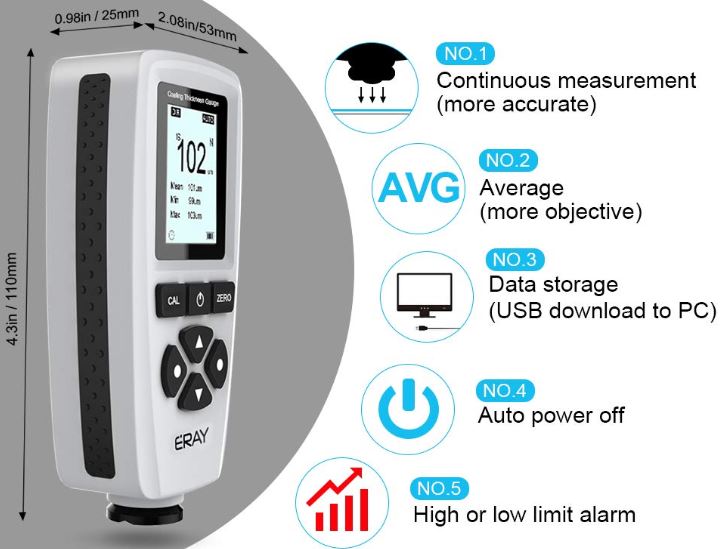
Build & Design
The ERAY Gauge measures roughly 4.3 x 2.0 x 1.0 inches, which is pretty handheld. The front of the instrument is fairly intuitive; there are four arrow keys alongside three well-labeled function buttons. You probably don’t need to flip through the user manual to figure out what the “zero” button does.
About half of the entire device is covered by the display, a 128 x 128 dot matrix LCD. On the display, your data resolution reads out to 99.9um — giving you 0.1um intervals for each reading
It also provides plenty of room to sort through various menu options, and for displaying the max data, min data point, standard deviation, and the mean.
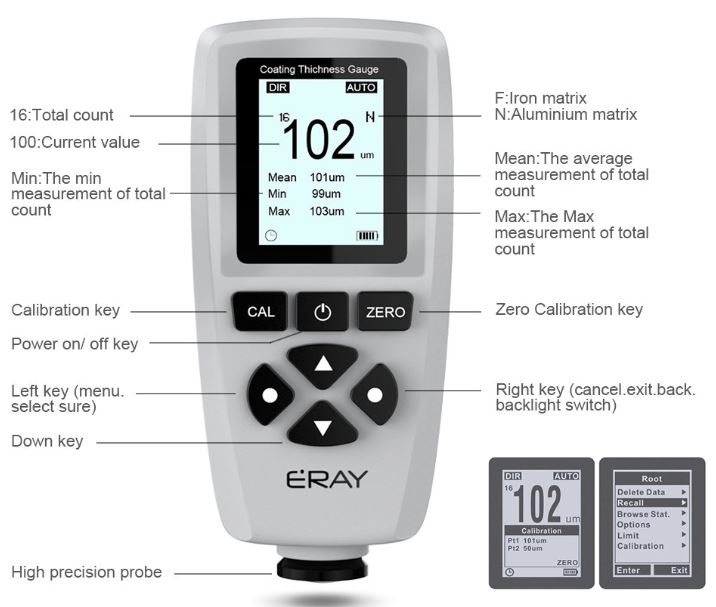
The display also provides an error indicator if you can’t get a clear measurement, and a low battery indicator to help keep your instrument in action. There’s a zeroing function and a multi-point calibration feature you can use for every testing group you establish. Additionally, you can setup low or high alarm limits for any particular profile you create.
Because there are four profile groups you can create, it’s possible to separate data groups and non-data groups. Each group can have its own alarm settings, special limits, and even its own calibration. In other words, you can take data readings without having them stored to memory.
If you do decide to save your data, then this instrument can handle about 320 readings. After that, you’ll need to clear your saved data.

Other Considerations
There are two separate measure modes you can select between. The first is single mode, and the second is continuous mode. The single mode lets you take individual measurements. Pretty handy for when you know just where you want to aim the device. The continuous mode is good for taking a constant stream of measurements. If you want to run the thickens gauge along a lengthy area of a paint job, the continuous mode can be handy to have.
This kit includes the coating thickness gauge, an aluminum substrate, USB cable, pair of AAA batteries, iron substrate, software disc, tool kit, and a user manual. It also includes a hard-shelled carrying case with foam outlets for instrument and its accessories. Unfortunately, the case is pretty large, so it’s not optimal for storage.
Extech CG204 Coating Thickness Tester
Similar to the ERAY meter, the Extech CG204 Coating Thickness Tester was also made to provide non-invasive paint thickness measurements. Consequently, this instrument is based around dual probe technology that helps recognize magnetic induction and eddy current independently. It also has two separate measurement modes and operation modes, allowing it to better match the needs of any particular project.
And the CG204 was built to precision standards. Its measurement range stretches out to 1250μm, with a basic accuracy within about 3%. The minimum curvature measurement is 1.5mm for a ferrous metal, or 3mm for a non-ferrous metal. The minimum diameter for measurement is 7mm with a ferrous metal or 5mm for a non-ferrous metal.

Build & Design
The CG204 is quite compact. It measures 4.7 x 2.4 x 1.2 inches and weighs nearly seven ounces with the batteries shoved inside. You need two AAA batteries to power it, which are included. You can stick those into the backside of the green chassis of the instrument, underneath the orange grip. A pretty standard design for Extech.
Most of the device’s front has been taken up by the display, but a good portion was set aside to make some sizeable analogue control buttons. The buttons are fairly intuitive, upwards and downwards arrow keys help you navigate the instrument, while a couple of the buttons can be used as multi-function buttons.

The display is pretty easy to read, and it shows a variety of data bout measuring modes, statistical analysis, low battery indicators, and so on. It even lets you know if the CG204 is currently connected through USB, which can be handy for troubleshooting purposes.
In order to access the USB connection and move your data to PC, you’ve got to pop-open a little rubber hatch on the top of the instrument. This instrument also includes software from Extech, to help you view your data, or export it into different programs later.
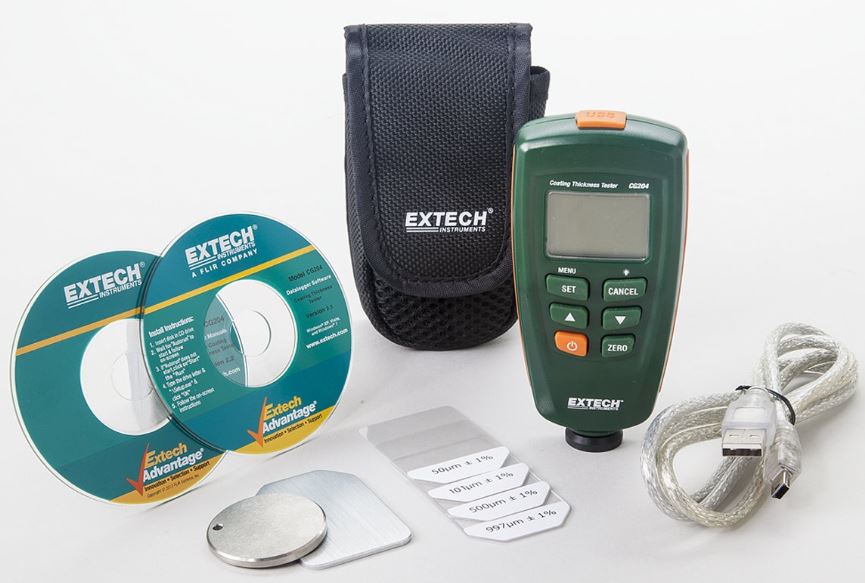
Other Considerations
The direct mode will clear readings when you turn off the meter, but saves statistical analysis of the data you collected. By contrast, the group mode stores readings and your statistical information, as well as alarm values and calibration settings for each profile group you create. It’s important to keep that in mind if you don’t want to lose your data.
The CG204 comes with built-in memory for data storage, and has the same high/low programmable alarm system you’ll find with the ERAY Gauge. This meter also provides statistical analysis for average value, median, and standard deviation. It can store a total of 80 direct readings, or 320 group readings. Single mode measurements are taken one at a time, and occur with an audible beep. Continuous measurements dispense with the beeping, thankfully.
This kit includes two AAA batteries, a user manual, USB cable, carrying pouch, user software, and calibration metal kit. The calibration metal kit includes both iron and aluminum, so you’re ready to calibrate for whatever your next project might be.
REED Instruments CM-8822 Coating Thickness Gauge
The REED Instruments CM-8822 was made for adaptability and throughput. With respect to versatility, it’s capable of taking on substrates which are both ferrous or non-ferrous. It offers a user-selectable µm/mils option, as well as a pretty impressive automatic calibration feature. It also operates with a pretty lengthy probe that can let you get measurements from almost anywhere.
With respect to throughput, you’ll find this instrument is slightly better suited for plastic substrates more than metallic ones. And it’s not especially well suited for magnetic surfaces. But when used on the right materials, you’ll find the accuracy of the CM-8822 is within 2 micrometers. You just can’t beat it for this price.
Build & Design
The blue-and-gray CM-8822 measures 1.25 x 6.3 x 2.7 inches. The meter itself looks a little dated, but there’s nothing dated about its accuracy. Good measurements are timeless. Here you’ll find a probe design made specifically for taking readings in tight spaces, and the CM-8822 includes a pair of narrow probes for that purpose.
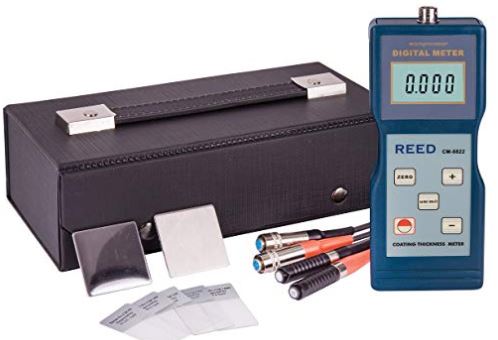
REED claims their display is easy to read, but it’s actually one of the smaller and dimmer displays you’ll encounter on a paint coating thickness gauge. Even though the actual instrument is pretty impressive, the display is a bit underwhelming.
It’s not unreadable by any means, it’s just a little ugly, and by modern standards, a little old looking. There isn’t any backlighting, either. Not everyone needs that kind of feature. For most people it’s probably just an unnecessary battery drain. But since this is supposed to be a top-shelf instrument, it’s worth noting when those top-shelf details are missing.
Other Considerations
As mentioned earlier, the CM-822 includes a pair of measuring probes, with cables that run about four feet. There is actually a separate ferrous and non-ferrous probe, as well as a hard-shell carrying case that’s of reasonably high quality.
The front side has latching buttons, and the whole thing is covered with fabrics, so it doesn’t look like cheap junk. Even the handle feels pretty nice in your hand. It includes batteries for operation, and two sets of calibration metal.
Choosing Between 3 Great Paint Coating Thickness Meters
For an introductory instrument that won’t let you down, the ERAY Coating Paint Thickness Gauge is a pretty good choice. It provides a lot of options for car owners. It’s smartly designed, modern looking, and has essential levels of software support. And it’s a particularly good choice for someone who can take advantage of its higher measurement range and backlit display.
The Extech CG204 Coating Thickness Tester is somewhere between the REED CM-8822 and the ERAY Gauge. It provides many of the same measuring modes and alarm setting, but is capable of storing considerably more data, and doing far more with your data. For contact measurements that don’t require the extension powers of a probe, this is an excellent choice.
Trying to measure the thickness of plastics or non-metallic surfaces? The REED Instrument CM-8822 is pretty well suited to those kinds of applications. It can also be turned to measuring ferrous and non-ferrous objects with considerable success, but it’s really the measurement probes that help distinguish this from a contact-measurement instrument like the ERAY meter. For taking measurements in tight spaces without losing any accuracy, the CM-8822 is probably your best bet.
Meet Ry, “TechGuru,” a 36-year-old technology enthusiast with a deep passion for tech innovations. With extensive experience, he specializes in gaming hardware and software, and has expertise in gadgets, custom PCs, and audio.
Besides writing about tech and reviewing new products, he enjoys traveling, hiking, and photography. Committed to keeping up with the latest industry trends, he aims to guide readers in making informed tech decisions.

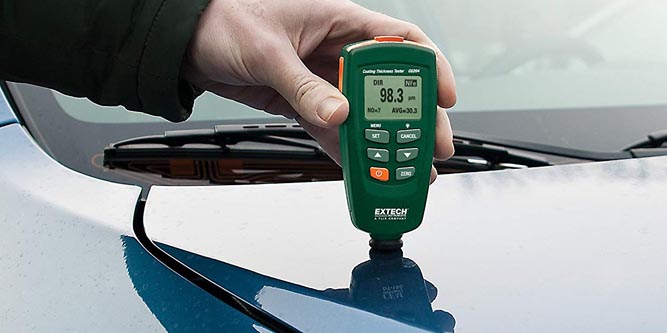
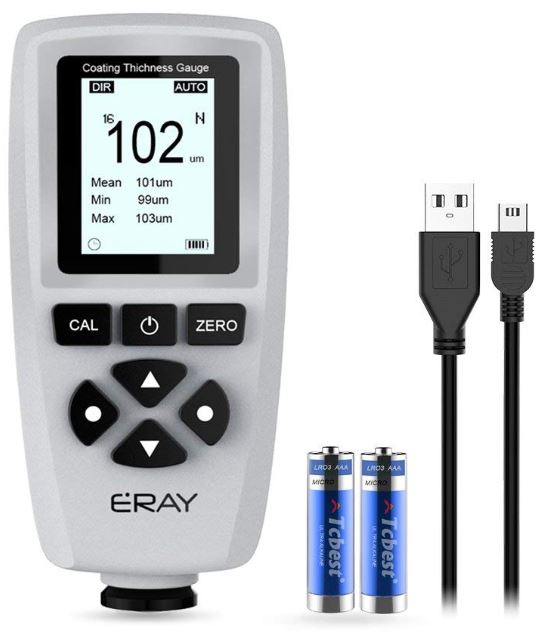

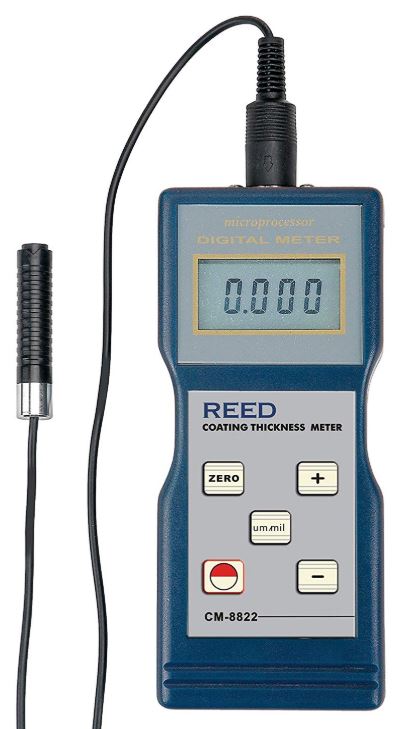
As I was looking for a tool that can give the paint reading, but it is hard to select the best paint coating thickness gauge as per our requirement. This article helped me to find the perfect one.
Thank you for sharing your knowledge with the world.
Glad we could help!